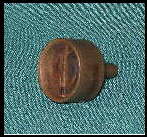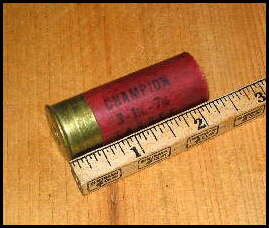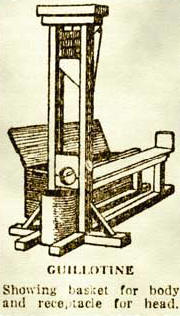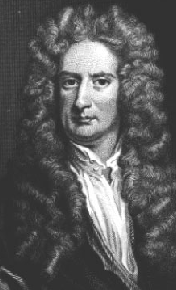| Reduced Black Powder Loads for the Shotgun by
Red Sun SASS#635
Last month we talked about where shotgun barrel length
came about to being at a standard 30 inches and why a shorter barreled
gun may have been preferred. We also commented about how much more evident
the muzzle “flame” is on shorter barreled guns. Now the opportunity here
is whether we can load less BP in the shotshell and still effectively accomplish
the task of taking down those targets. So whether we are using a long or
short barrel, do we really need 60-70 grains of BP? I’m sure you’ve noticed
that the cost of components have risen sharply over the past year. Being
a little frugal and maintaining good knockdown power can be a good thing.
I know that 50 grains and ¾ oz of #8 shot is an effective load with
my 30 inch barreled Parker hammer gun. With the 2½ Dram (65+ grains)
load, I average about 100 shotshells. With this reduced load, I can get
18-20 more shotshells from one lb of BP. That’s significant from a cost
standpoint. In addition, dropping down from 1 to ¾ oz of shot will
stretch a 25 lb of shot out from 400 to 500 shotshells. And you know what
the price of lead shot has gone to. So the question remains, can we go
lower? I have tried a few at lower proportions with good results, but before
we get into this, let’s look at some other things.
In my previous set of articles, “Reloading Black Powder
Shotshells with Antique Tooling”, I showed a number of components being
loaded into a shortened case (trimmed to 2½ inches) due to
the vintage shotgun having short chambers. This load was configured with
a conventional 1 oz of shot and 2½ Drams of powder. The stack used
a plastic shot cup with the spring section removed, an over powder card,
½” wad, and over shot cards being made of paper and felt. As we
reduce the BP load, the stack changes so we can adjust by either increasing
the wad thickness or trim the case to a shorter length. Let’s op to trim
that case down to maybe 2¼ inches. Roll crimping will result in
a 2 inch finished shell. I have recently seen some 1¾” smokeless
shotshells that are fold crimped being sold at the gun shows. A CAS shooter
at Pala had some of these and it was quite noticeable how easily the empties
dropped out from the chambers. We know that BP fowling buildup in the chambers
starts to hamper clean drops. So these shorter shells will have less surface
area contacting the inner wall of the chambers. The hypothesis is that
with less wall contact, we should have less friction hampering a clean
drop. Another good reason for trying a shorter shotshell case!
| Let’s first look at how we get those cases cut down.
If we go to the 2¼” length, it’s more practical to roll crimp them.
You don’t need a vintage roll crimper or case trimmer. A roll crimping
tool (shown at right) can be purchased from Ballistic Products that can
use on a drill press. A shotshell trimmer can also be purchased from same
supplier. These 2 items will total about $55 and this supplier is currently
offering free shipping. (www.ballisticproducts.com) |
 |
|
|
The BP load we’re going to try is using a 2.8cc Lyman
scoop. It poured an average of 43.7 grains over 10 scoops. This represents
the target reduction of 15%. The shot weight will be at ¾ oz. A
3.7cc scoop delivered an average of 355 grains for the #8 shot. There are
437.5 grains per oz. The math gives us proportionately 355/437.5 = 0.81
or just a little over ¾ oz. We’ll use a Remington Power Piston wad
for 1 oz with the spring base cut off. This 4-petal configuration with
an internal rib will hold the shot closer together upon exiting the muzzle.
With the shotgun targets being at 5-7 yards, getting a tighter shot pattern
on the plate will help with the knockdown power. |
| For the trimming process and roll crimping, I will use
my vintage tools for this experimental load but the tools from Ballistic
Products will effectively provide a similar finished shotshell. At right
is the trimmed shotshell case at 2¼ inches. Below is one of the
FFg BP load from the 2.8cc Lyman scoop weighing in at 43.4 grains.
|
 |
Next month, we’ll report on chronograph results and a few
pics on the visual muzzle blast. But more important will be taking down
those targets with a clean drop for the reload.
Happy Reloading,
Red Sun |
| The Paterson Colt by Kerry Barlow ------ This
article was published in Western Territories magazine. Used here with
permission from the author.
Born in 1814, Samuel Colt was to have a major impact upon
gun manufacture. The guns subsequently produced by his Colt Company were
to have a significant impact upon the United States, as well as the rest
of the world. In the course of only a few short years, his guns would go
on to be the most widely used handguns of the civil war with both U.S.
and Confederate troops. Sam Colts first handgun the Paterson Colt was a
major advancement in the development of handguns.
Prior to 1836, handguns were generally of a single shot
variety, being called pistols. Loading and firing of these single shot
handguns was problematic at best. A single shot weapon was too time consuming
to reload. In Texas and parts of the United States, as the troops were
continually thrown into combat, attempting to reload a single shot weapon
during battle was too much of a disadvantage for a soldier.
Colts design of a revolving cylinder was not entirely
a brand new concept, as many as 200 years previously, rotating cylinders
had been tried in matchlock pistols, however with indifferent success.
Other revolving cylinder designs were more recent; including a 4 barreled
revolving flintlock pistol, and a Collier revolving system. At the time
of Colts patent for the Paterson revolver, American gunsmith Edwin Wesson
(of Smith and Wesson fame) was developing a similar pistol. Colt won the
British and American patents to the weapon in 1835 and 1836, and today
is acknowledged as the inventor of the modern revolver type pistol.
Samuel Colt went to sea at the age of 16 and during his
first voyage he made a wooden model of a revolver. When he returned to
the United States he secured patents for his single barrel revolving pistol
design, the Paterson Colt.
Colt formed a company to design and build the pistol called
the Patent Arms Manufacturing Company of Paterson New Jersey. The handgun
was forever to carry the name of the actual location where it was manufactured
in Paterson. Samuel Colt was sort of an early Henry Ford in that he believed
in making guns with many interchangeable parts and building them in an
assembly line process. This more then any other may be the reason for the
huge success of the Colt weapons.
The Paterson Colt was a 5 shot revolver with a dropout
trigger. This meant that when not in use the actual trigger of the gun
was not visible, and there was no trigger guard around the trigger itself.
This gave the revolver a very unique look to it. The main innovation of
course was the rotating cylinder that could hold 5 shots, either bullet
or ball. One shot would be loaded into each cylinder, and the act of pulling
the hammer back on the gun would rotate the cylinder, aligning the cylinder
with the single barrel of the gun. At this point the trigger would drop
out of the frame of the gun allowing the shooter to fire the weapon. The
Paterson was sold in 2 & ½" to 12" barrel lengths the longest
12" was called a Buntline. The majority of the weapons had a 7 and ½"
or 9" barrel. Bore diameter or caliber came in many wide varieties, including
.28, .31, .34, and .36 caliber. The larger caliber generally would have
had the longer barrels as well. A different but very important difference
in Paterson models was the method of loading the weapon. Many Patersons
did not have the soon to be modern design of an attached loading lever.
Without an attached loading lever a shooter would be required to load powder
and ball, and then use a ramrod to push the ball firmly onto the powder.
This had many disadvantages, not the least of which, it required a lot
of strength to force a ball into its chamber, losing the ramrod would be
even worse. Other models of the Paterson had an attached loading lever.
This lever was used to force the ball into its chamber, being always attached
to the gun; the lever greatly improved the Patersons functionality. The
vast majority of all modern revolvers would have this attached loading
rod.
The Paterson had a marked influence on the early west,
and was a sought after handgun. Examples of the Patersons success abound,
the Paterson alone being responsible for saving wagon trains from attack,
as reported by the famous Kit Carson, or 12 soldiers pinned down by over
60 Indians and living to tell about it by Col. Jack Hayes. One surviving
Indian encountering the Paterson revolver was quoted as saying the following
"Him no good" this simple comment holds a lot of truth in its statement,
compared to a single shot handgun the Paterson "was" no good for the enemy.
The Patersons greatest success and Colts claim to early fame was garnered
from the Republic of Texas. The Texas Rangers used the Paterson Colt with
huge success, earning the weapon a new name the "Texas Paterson"
It is interesting to note that Colts original company
"Patent Arms Manufacturing Company" was an actual failure, more Patersons
were built then were sold by the company. Nobody may know why the original
company failed, possibly the Patersons high price for the day of $40-50
was the reason, possibly the gun itself was to innovative for its time,
certainly it was a radical departure from the concept of single shot handguns.
Possibly there was just not much need for a 5 shot revolver at the time
of its sale, remember this was before the civil war, and the Country was
relatively at peace. Despite all this, Colt later went on to open the Colt
Company and produced his next model revolver the Walker Colt.
The Walker was designed by Captain S.H. Walker a Texas
Ranger who had used the Paterson and had ideas for its improvement. The
Walker retained many of the Patersons original ideas, the attached loading
lever, and of course the revolving cylinder (now in 6 shots, and .44 caliber).
Colt went on to design many thousands of handguns to be used in the Civil
war by both sides in a logical progression, the Walker Colt, 1st, 2nd,
3rd model Dragoons, the 1851 navy models and many other designs for police
and pocket protection. All of these designs were built upon the original
Paterson Colt, designed by a young man on his first voyage at sea.
You
will find Kerry Barlow's article here with links to more of his work
|
| Colt 1851 Navy Revolver From Wikipedia, the free
encyclopedia
Samuel Colt designed the Colt Revolving Belt Pistol of
Naval Caliber (i.e., .36 cal) between 1847 and 1850-the actual year of
introduction. It remained in production until 1873 when revolvers using
fixed cartridges came into widespread use. Total production numbers were
exceeded only by the Colt Pocket models in concurrent development and numbered
some 250,000 domestic units and about 22,000 produced in the Colt London
Armory. (Wilson, 1985)
The designation "Colt 1851 Navy" was applied by collectors,
though the popular name "Navy Revolver" is of early origin, it was frequently
called the "Colt Revolving Belt Pistol of Naval Caliber." (ibid, Wilson)
The cylinder is engraved with a naval battle scene celebrating the victory
of the Second Texas Navy at the Battle of Campeche in May 1843. The Texas
Navy had purchased the earlier Colt Paterson Revolver and this was Colt's
first major success in the gun trade; the naval battle theme of the engraved
cylinder of the Colt 1851 Navy revolver was Colt's gesture of appreciation.
Despite the "Navy" designation, the revolver was chiefly purchased by civilians
and military land forces(ibid Wilson 1985).
Famous "Navy" users included Wild Bill Hickok, Richard
Francis Burton, Ned Kelly, and Robert E. Lee. Usage continued long after
more modern cartridge revolvers were introduced in 1873.
Characteristics
The .36 caliber Navy revolver was much lighter than the
contemporary third model Dragoon revolvers that developed from the .44
Walker Colt revolvers of 1847 that had been designed to be carried in holsters
on either side of a saddle pommel. It is an enlarged version of the 31
caliber pocket revolvers that evolved from the earlier baby dragoon and
is a mechanically improved and simplified heir of of the 1836 Patterson
revolver. As the factory designation implied, the Navy revolver was suitably
sized for carry in a belt holster. It became very popular in North America
at the time of western expansion. Colt's aggressive promotions distributed
the Navy and his other revolvers across Europe, Asia and Africa. The .36
caliber (.375-.380-inch) weights 86 grains and, at a velocity of 1,000
feet per second, is comparable to the modern .380 pistol cartridge in power.
Loads consist of loose powder and ball or bullet, Metallic foil cartridges
(early) and, combustible paper cartridges (Civil War era) all combinations
being ignited by a fulminate percussion cap applied to the cones at the
rear of the chamber.
|
| Kansas Cowtowns at LEGENDS
OF AMERICA and other interesting
items. |
| Who, Really ?
Throughout history, the British
have been responsible for many great inventions and are still commonly
acknowledged to be among the best in the world when it comes to inventing.
Over the past 50 years, according to Japanese research, more than 40 per
cent of discoveries taken up on a worldwide basis originated in the United
Kingdom.
Many of these British inventions
have had an enormous impact on the world. For example, imagine how different
life would be today if Michael Faraday had not built the first simple electrical
generator or if James Watt had not developed the steam engine?
Leading British author Terry
Deary has discovered some other pretty spectacular British 'firsts',
some of which have not been traditionally attributed to the Brits.....
1. Powered flight
They say …
During 2003,
Dayton, Ohio, and the Dayton & Montgomery County Public Library will
be celebrating the 100th anniversary of the Wright Brothers invention of
the first powered airplane. The first successful flight occurred on December
17, 1903 at Kill Devil Hills in Kittyhawk, North Carolina. But hang on
… the Wrights may have made “The first successful flight” but they could
not claim “the invention of the first powered airplane” because …
Brits say …
Brit Percy Pilcher
designed a powered triplane and built it in 1899. By the last day of September
1899, Pilcher's powered triplane was very nearly ready for flight (save,
apparently, for mounting the engine), but on that day Pilcher was gliding
in his "Hawk." His previously reliable "Hawk" suffered a structural failure,
fell, and Pilcher died two days later. Pilcher's powered triplane was never
flown. But the “invention” beat the Americans by 4 years.
Or maybe it was
Bill Frost a Welsh carpenter who patented the aeroplane in 1894 and took
to the skies in a powered flying machine the following year (8 years before
the Wright brothers)
Or maybe the
world's first powered flight took place not in America in 1903, but at
Chard in Somerset 55 years earlier, and the man who made it happen was
John Stringfellow
| 2 The Guillotine
During the French
Revolution M. Guillotin invented a machine for slicing off heads quickly
and painlessly. It was pretty successful – though not quite so clean-cut
as some people imagine. It took a couple of chops to get through fat King
Louis’ neck. But the idea was 500 years after a British invention, “The
Halifax Gibbet” because.....
The Guillotine
wasn’t a French invention. There was one in Halifax, West Yorkshire, from
the 13th to the 17th century. The earliest recorded execution was in 1286.
Convicted criminals did have one thing going for them. For hundreds of
years the law stated that if a condemned person could withdraw his or her
head after the blade was released and before it hit the bottom, then he
or she was free. The good old British idea of a “sporting chance”. The
one condition: that person could never return.
3 Electric Light Bulb
They say …
Thomas Alva Edison
invented the light bulb. He began his experiments in 1878 and by 21 October
1879 he made a working electric light bulb. Fine, but …
Brits say …
Sir Joseph Swan
of Newcastle announced that he had made a working light bulb on 18 December
1878 and on 18 January 1879 he gave a public demonstration in Sunderland
– 10 months before Edison. The Americans say it was just a working model
and not a commercial reality … but then they would say that, wouldn’t they? |
 |
4 Telephone
They say …
The first telephone
message was made at 5 Exeter Place, Boston, Massachusetts on 10 March 1876.
Alexander Graham Bell called to his assistant, “Come here, Watson, I want
you.” In June that year it was demonstrated at the Centennial Exhibition
in Philadelphia and may have passed unnoticed if the Emperor of Brazil
hadn’t caused a sensation by crying out, “My God … it talks!” The rest,
is history. But …
Brits say …
Alexander Graham
Bell was born in 1847 in Edinburgh, Scotland. He moved to Canada when he
was 23 and only then migrated to the USA. He was British so Brits can rightly
claim the telephone is a British invention.
5 Radio
They say …
On 23 July 1866
Mahlon Loomis of Washington DC described how to send signals by radio.
That October he achieved it in Virginia. In 1896 Guliemo Marconi won even
greater fame for sending a wireless telegraph over 94 miles. But …
Brits say …
David Edward
Hughes, (D.E.Hughes), of Corwen (Denbighshire) – is recorded as the Welshman
who became the first person in the world to transmit and receive radio
waves. Evans, resident of North Wales, designed the synchronous type-printing
telegraph in 1856. Yet another British first.
So forget the
Wright Brothers, Marconi, Thomas Edison and Monsieur Guillotin. All they
had was good PR. In their own quiet, modest way the Brits were always there
first.
6 Discovering America
They say …
In fourteen hundred
and ninety-two
Columbus sailed
the ocean blue.
The Italian adventurer,
Columbus, finally persuaded the Spanish to back an expedition across the
Atlantic. They reckon he was the first European to discover America. But
he wasn’t.
Brits say …
In 1170 Welsh
prince Madog ab Owain Gwynedd sailed from Wales in search of new lands
and reached America. He then returned to Wales to tell his fellow countrymen
of the great wonders that he had found. They are believed to have landed
at Mobile Bay, Alabama and then travelled up the Alabama river along which
there are several forts said by the local Cherokee Indians to have been
constructed by "White People". These structures have been dated to several
hundred years before Columbus and are of a similar design to Dolwyddelan
Castle. An Indian tribe was discovered in the 18th century called the Mandans.
This tribe were described as white men with forts, towns and permanent
villages laid out in streets and squares. They claimed ancestry with the
Welsh and spoke a language remarkably similar to it. Unfortunately the
tribe was wiped out by a smallpox epidemic introduced by traders in 1837.
A memorial tablet has been erected at Port Morgan, Mobile Bay, Alabama
which reads: "In memory of Prince Madog, a Welsh explorer, who landed on
the shores of Mobile Bay in 1170 and left behind, with the Indians, the
Welsh language."
7 Motor car
They say …
Karl Benz created
the first motor car in Germany in 1889. It covered just over half a mile
at nine miles per hour. People have been driving Mercedes Benz cars ever
since – usually slower than nine miles an hour in rush hour traffic. But
…
Brits say …
180 years before,
in 1711, Christopher Holtum demonstrated a horseless carriage. It gave
demonstrations under the piazzas at Covent Garden and travelled at five
or six miles an hour.
| 8 Jet propulsion
They say …
In 1796 the American,
James Rumsey, drove a steam-powered boat that worked by pushing out a jet
of water. It travelled at 4 mph. It became a popular motor for model
boats and the US claimed the first jet-propelled vehicle. But …
Brits say …
The great Sir
Isaac Newton invented the jet-powered car. He forecast that one day people
would travel at 50 miles an hour. In 1680 a man called Gravesande designed
a car that would be powered by Newton’s third law of motion – “To every
action there is an equal and opposite reaction.” A boiler sent out a jet
of steam that pushed the car along. Of course everyone on the road behind
the jet engine would have been scalded, but that’s a small price to pay
for progress. |

Sir Isaac Newton |
9 Photography
They say …
Louis Daguerre
produced the Daguerrotype camera in France. He was actually carrying on
the work of a colleague Called Niepce. But Niepce made the clumsy error
of dying in 1833 before it was perfected and he is forgotten. In 1838 Daguerre
demonstrated a working method of producing photographs. But …
Brits say …
Niepce was basing
his work on the experiments of Thomas Wedgewood – son of the famous potter
Josiah. He used silver nitrate and made images of insect wings and leaves
on pieces of sensitised leather. His friend Humphrey Davey was doing similar
work and they published their findings in 1802 – 36 years before Daguerre.
10 The submarine
They say …
The Americans
claimed that in the 1700s David Bushnell created the first usable submersible.
It was christened “The Turtle”. It’s purpose was to sneak up on British
ships in the American War of Independence and screw a mine into the wooden
hull. Unfortunately when it tried to attack HM Eagle the submariners discovered
the hull covered in copper. They couldn’t bore into it. The mine went off
but the only victims were an unlucky shoal of fish.
Brits say …
There was an
English submarine that was not only demonstrated in the early 1600s but
gave a test-ride to King James I. The design was created in 1578 by William
Bourne, a mathematician. A Dutchman called Cornelis Drebbel came to London
to test it in the Thames. Between 1620 and 1624 he did many tests; his
oar-propelled craft worked at depths of five metres for several hours.
Even the free trip for the King didn’t get a commission from the Navy!
|
All articles submitted to the "Brimstone
Gazette" are the property of the author, used with their expressed permission.
The Brimstone Pistoleros are not
responsible for any accidents which may occur from use of loading
data, firearms information, or recommendations published on the Brimstone
Pistoleros web site. |
|